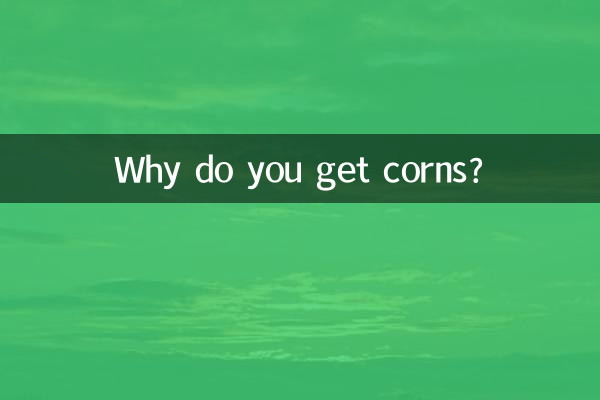Why do you get corns?
Corns are a common foot skin problem that often results from prolonged friction or pressure. Although corns may seem small, they can cause considerable pain and discomfort. This article will combine the hot topics and hot content on the Internet in the past 10 days to analyze the causes, symptoms, prevention and treatment methods of corns in detail, and provide structured data for readers' reference.
1. Causes of corns

Corns are caused by long-term friction or pressure on the skin, resulting in local thickening of the stratum corneum. The following are common causes:
| Cause | Specific performance |
|---|---|
| ill-fitting shoes | High heels and shoes that are too tight or too loose can increase pressure on your feet |
| standing or walking for long periods of time | Increased foot friction due to occupational demands or excessive exercise |
| foot deformity | Deformities such as flat feet and hallux valgus will change the distribution of force on the foot. |
| Lack of foot care | Failure to promptly trim thick calluses or use moisturizing products |
2. Symptoms of corns
Corns usually appear as local thickening of the skin, and there may be a hard core in the center that can be painful when pressed. The following are typical symptoms of corns:
| Symptom type | Description |
|---|---|
| hard corns | It is more common in toe joints or soles, with hard texture and obvious pain. |
| soft corns | Commonly found between toes, softened by moisture and susceptible to infection |
| Redness and swelling around corns | If secondary infection occurs, redness, swelling, and pus may occur |
3. How to prevent corns
The key to preventing corns is reducing friction and pressure on your feet. The following are prevention methods that are hotly discussed across the Internet:
| Precautions | Specific methods |
|---|---|
| Choose the right shoes | Wear loose, soft-soled shoes and avoid high heels |
| Use foot protection pads | Apply silicone pads or band-aids to areas prone to friction |
| Keep feet clean and dry | Change socks frequently and use moisture-wicking materials |
| Trim your cuticles regularly | Use a pumice stone or cuticle file to gently remove thick calluses |
4. Treatment methods for corns
If you already have corns, you can try the following treatments. If symptoms are severe, it is recommended to seek medical treatment promptly.
| Treatment | Operation steps |
|---|---|
| corn patch | Eye patches containing salicylic acid can soften cuticles and need to be used continuously for several days |
| Soak in warm water | Soak your feet in warm water for 15-20 minutes every day to soften the corns and then remove them gently. |
| Seek medical treatment | Doctors may use freezing, laser or surgical removal |
| Traditional Chinese Medicine Recipes | Vinegar foot soaks, ginger slices, etc. (Try with caution) |
5. Popular discussions on corns in the past 10 days across the Internet
According to recent network data, the following are hot topics and user concerns about corns:
| platform | hot topics | Discussion popularity |
|---|---|---|
| #consequences of wearing high heels for a long time# | Reading volume: 12 million+ | |
| little red book | "Corns Self-Rescue Guide" | Like 50,000+ |
| Zhihu | "Will corns go away on their own?" | Answer 300+ |
| Douyin | “Tricks to get rid of corns in 3 days” | 8 million+ views |
6. Summary
Although corns are common, they can be avoided or solved with the correct prevention and treatment measures. Choosing the right shoes, reducing pressure on your feet, and maintaining foot hygiene are key. If the symptoms of corns are severe or recurring, it is recommended to seek medical treatment in time to avoid infection caused by self-treatment. Hopefully this article’s structured data and trending topic analysis will help you better understand and manage your corns problem.

check the details

check the details